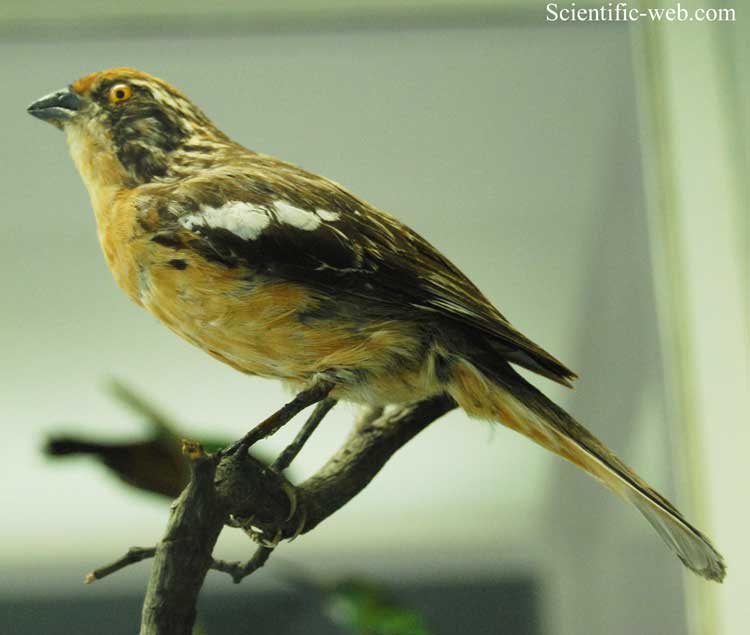
Phytotoma rara , Photo: Michael Lahanas
Superregnum: Eukaryota
Cladus: Unikonta
Cladus: Opisthokonta
Cladus: Holozoa
Regnum: Animalia
Subregnum: Eumetazoa
Cladus: Bilateria
Cladus: Nephrozoa
Superphylum: Deuterostomia
Phylum: Chordata
Subphylum: Vertebrata
Infraphylum: Gnathostomata
Megaclassis: Osteichthyes
Cladus: Sarcopterygii
Cladus: Rhipidistia
Cladus: Tetrapodomorpha
Cladus: Eotetrapodiformes
Cladus: Elpistostegalia
Superclassis: Tetrapoda
Cladus: Reptiliomorpha
Cladus: Amniota
Classis: Reptilia
Cladus: Eureptilia
Cladus: Romeriida
Subclassis: Diapsida
Cladus: Sauria
Infraclassis: Archosauromorpha
Cladus: Crurotarsi
Divisio: Archosauria
Cladus: Avemetatarsalia
Cladus: Ornithodira
Subtaxon: Dinosauromorpha
Cladus: Dinosauriformes
Cladus: Dracohors
Cladus: Dinosauria
Cladus: Saurischia
Cladus: Eusaurischia
Subordo: Theropoda
Cladus: Neotheropoda
Cladus: Averostra
Cladus: Tetanurae
Cladus: Avetheropoda
Cladus: Coelurosauria
Cladus: Tyrannoraptora
Cladus: Maniraptoromorpha
Cladus: Maniraptoriformes
Cladus: Maniraptora
Cladus: Pennaraptora
Cladus: Paraves
Cladus: Eumaniraptora
Cladus: Avialae
Infraclassis: Aves
Cladus: Avebrevicauda
Cladus: Pygostylia
Cladus: Ornithothoraces
Cladus: Ornithuromorpha
Cladus: Carinatae
Parvclassis: Neornithes
Cohors: Neognathae
Cladus: Neoaves
Cladus: Telluraves
Cladus: Australaves
Ordo: Passeriformes
Subordo: Tyranni
Infraordo: Tyrannides
Parvordo: Tyrannida
Familia: Cotingidae
Genus: Phytotoma
Species: Phytotoma rara
Name
Phytotoma rara Molina, 1782
Type locality: Chile.
References
Primary references
Molina, J.I. 1782. Saggio sulla Storia Naturale del Chili. Stamperia di S. Tomaso d'Aquino: Bologna. 367 pp. Reference page. p. 254 Internet Archive p. 345
Vernacular names
English: Rufous-tailed plantcutter
español: Rara
The rufous-tailed plantcutter (Phytotoma rara), sometimes called the Chilean plantcutter, is a passerine bird of southern South America, now placed in the cotinga family. It is a medium-sized bird about 19 centimetres (7.5 in) long with a long black tail with a red base. Males have greyish-brown upper parts, a chestnut crown and breast, and dark facial markings. Females are similar but lack the chestnut crown and have streaked, buff underparts. There is a wing bar which is white in the male and buff in the female. This is a fairly common species with a wide range, and the International Union for Conservation of Nature has rated its conservation status as being of "least concern".
Description
It is a stocky bird, 18-20 centimetres in length, with short wings and a red eye. The longish tail is black with a reddish base. The upperparts of the male are grey-brown with dark streaks while the crown and underparts are chestnut-coloured. There is a white bar on the wing and a pattern of dark and pale areas on the face. Females have buff underparts with brown streaks and have buff rather than white in the wings. They do not have the males' chestnut crown but may show a cinnamon wash to the forehead and throat. The song is a series of stuttering notes followed by a rasping trill similar to the noise made by a fishing reel.
The finch-like bill is short and thick with serrated edges and is used for stripping off buds, leaves and fruits. Insects are eaten on occasions and are fed to the chicks.
Distribution and habitat
The rufous-tailed plantcutter is found further south than any other cotinga, inhabiting scrub, forest edge and river valleys in Chile and western Argentina. The range extends from Magallanes region north to Atacama in Chile and from Santa Cruz north to Mendoza in Argentina. Birds breeding in southern or high-altitude regions move northwards or towards the lowlands in winter. It has been recorded as a vagrant to the Falkland Islands. Birds are often seen in gardens, farmland and orchards and are sometimes considered to be a pest. The nest is a cup of root fibres and twigs built in a fork in a shrub or tree. Two to four eggs are laid, they are blue-green with dark spots concentrated at the larger end.
Status
This bird has a very wide range and though not particularly common, is presumed to have a large total population. The population trend is thought to be stable and the International Union for Conservation of Nature has rated the bird's conservation status as being of "least concern".[1]
References
BirdLife International (2016). "Phytotoma rara". IUCN Red List of Threatened Species. 2016: e.T22700770A93795753. doi:10.2305/IUCN.UK.2016-3.RLTS.T22700770A93795753.en. Retrieved 13 November 2021.
Alvaro Jaramillo, Peter Burke & David Beadle (2003) Field Guide to the Birds of Chile, Christopher Helm, London
Michael Walters (1994) Eyewitness Handbooks: Birds' Eggs, Dorling Kindersley`, London
Robin W. Woods (1988) Guide to Birds of the Falkland Islands, Anthony Nelson, Oswestry
Retrieved from "http://en.wikipedia.org/"
All text is available under the terms of the GNU Free Documentation License

